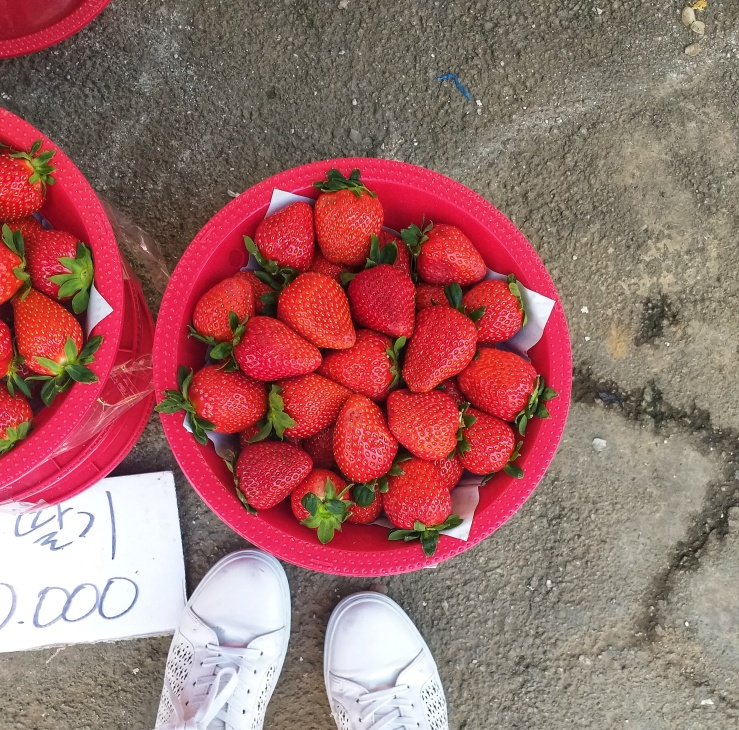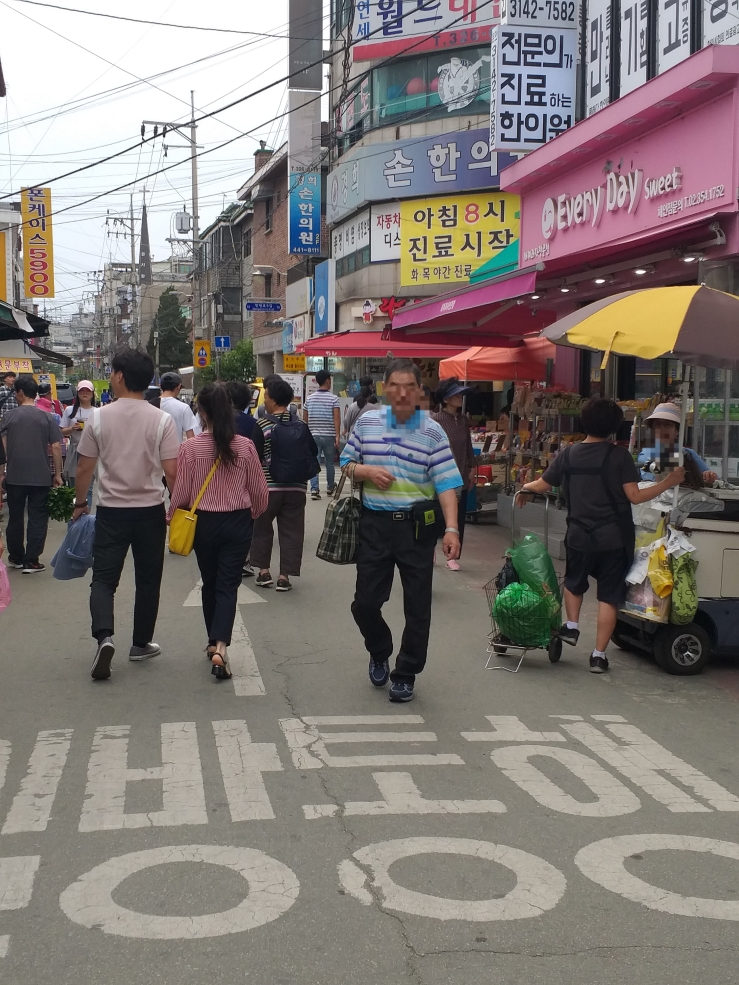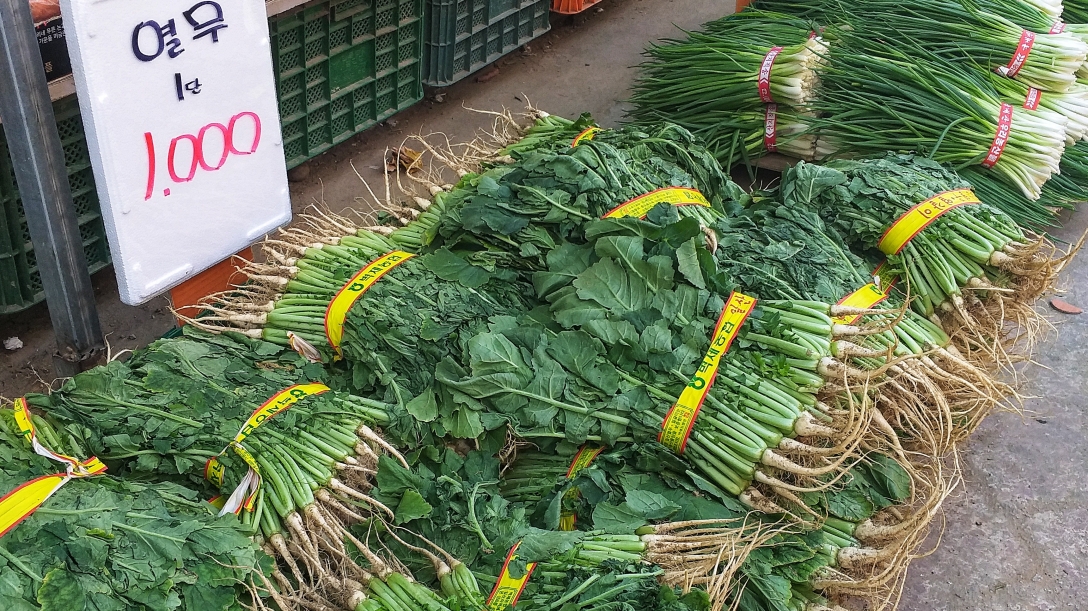Almost every newcomer to Seoul has Namdaemun market or Gwangjang market on their “must-see” list. When I first got here I also thought that these would be the best places to go if I wanted to have the most authentic traditional Korean market experience. They’re both massive gatherings of stalls selling everything from popular street food and fresh produce to kitchenware, leather pants, and traditional fabrics. You could spend hours there browsing, haggling, and eating. (And I have!)
But the thing is, these markets are kind of tourist-y and overpriced because of their popularity. To my delight, there are tons of smaller markets in nearly every district of Seoul that are mostly frequented by locals living in the area. These don’t get as much coverage in the travel guides and may be a little inaccessible for people who don’t speak Korean, but let me tell you–that’s where all the good deals are.
My favorite one is Mangwon market, right next to Exit 2 of Mangwon Station. I lived right next to it for three months when I was studying at Ewha, and it was one of the most convenient places I’ve ever lived in my life. I saved a ton of money and time because every fresh ingredient I needed was five steps from my front door.
Even though I live 30 minutes away from it now, I still make an effort to go because it’s one of the best places in Seoul for zero-waste shopping, if you come prepared. So, here’s some info, tips, and tricks on how you can make your trip to Mangwon market an eco-friendly one.
What you’ll need
- Your grocery list
- Cash
- Glass/reusable containers with a lid
- Reusable shopping bags
- Smaller fabric bags (for bulk items such as rice and beans)
Getting There
The official address for Mangwon market is 403-6, Mangwon-dong, Mapo-gu, Seoul (403-6 망원동 마포구 서울) and there are huge overarching sign designating the entrances, but the shopping starts after you take the first right out of Mangwon Station (Line 6) Exit 2.

You’ll find a lot of small storefronts flanking you on both sides for a couple of blocks, but on the third block you’ll start to see street food and produce vendors.


One of my favorite produce marts is this one on the left:

What to Buy
Here’s a taste of what they had in stock on this particular week:







The produce they stock plastic-free varies per shipment. One week they could have some fruit available without plastic and another week you could comeback and everything is wrapped. This pretty much goes for all stalls, so it’s good to make a full round, see the plastic-free offerings and compare prices before making purchases.
(The potatoes are a good find. First of all: That price!! Secondly: Even if supermarkets have individual potatoes, they usually make you put the potatoes you intend to buy in plastic and weight them, so cheap AND plastic-free potatoes? Yes yes! There’s a lot of other good stuff inside this store as well. The pics here only show the produce that’s outside.)
This whole road is basically produce stalls. Below I’ve included photos of produce items I found that were wrapped in plastic at one stall and plastic-free at another.


Peppers


Bananas
(I always buy bananas last and put them in a separate bag so they don’t get squished or bruised.)



Carrots and sweet potatoes


Cherries!

Celery. And even….

Tada! Strawberries!
(When you purchase them, empty the basket into your own container and leave the basket there.)
When you get to a pink snack store, you’ve reached the official entrance to Mangwon Market.


Take a right into the covered outdoor shopping area and you’ll find a ramen place and Daiso on your left, fried street food on your right.

If you’re looking to buy meat, there are several places for that on your right side as well. (I have no tips or suggestions for you about that since I’m vegetarian, sorry!) Keep walking and you’ll see this stall with a ton of plastic-free leafy greens that you can put into your own containers.


And next to that, there’s a guy selling tofu. Yes it is safe to buy it like this. I’ve never gotten sick eating tofu bought from this guy.


Then you’ll see a lot stalls selling seafood, tteok, and more fried street food. Go through this intersection.

Farther down there are stalls selling side dishes (called 반찬 [banchan] in Korean). Some side dishes come pre-packaged (single serving) and others don’t. It depends on the side dish and the stall. If you’re buying more than a single serving, then the owners will usually let you buy a portion from the bulk bin, weigh it out for you, and put it into the container you brought. Or, if you want something that they don’t have pre-packaged. Kimchi will almost always be available by weight, so no worries there.


Walk a bit more and on your left you’ll find a stall selling bulk grains and beans. Just tell the owner how much you want and give him your container. He will fill it and return it to you.


They’ve got barley, red beans, chickpeas, brown rice, white rice, white navy beans, lentils, Job’s tears, mung beans, millet, and more.
That should cover most of your produce essentials! If you keep going, you’ll run into more food stalls, some beauty/accessory stores, and kitchenware stores.
Tips and Tricks for Success
- Go on weekday mornings (10am-ish) to avoid the crowds. The locals flood this place on the weekends!
- Take a round around the market before you make a purchase. Take notes of prices and what’s available plastic-free to make sure you’re getting the best price for the most eco-friendly option.
- Buy heavy, sturdy, or bulky items first, like the kimchi, which will be going in a container. Save delicate fruits for last!
- Check out the trucks parked along the street before the entrance to the market. They might be selling nuts and seeds that you can’t find plastic-free inside.
- Sometimes produce will be priced for multiples. If you only need one or two of each item, you can ask the people running the stall. It’s a great way to reduce food waste!
- Eat before you go! If I shop when I’m hungry I buy too much of everything.
- Freeze extra fruit or veggies! If I find that I’ve bought too much produce like bananas or spinach, I just freeze it so I can use it for smoothies or something later.
Useful Korean Words and Phrases
Here are some basic Korean phrases you’ll need when shopping: Shopping Korean Phrases (90 Day Korean website). These might be helpful too:
- 봉투(가)필요없어요. I don’t need a bag
- (___를) 이 유리병에 넣어주세요 Please put it in this glass jar/bottle.
- 3개만 필요한데, 3개 사도돼요? I only need three of these, so can I just buy three? (Replace 3 with your desired number or amount, obvi. The 90 day Korean website should help you with counting objects in Korean, if you don’t know how to do so already.)
Other Points of Interest
There are a ridiculous number of restaurants and cafes in this area, on the same road as all the produce stalls. Stop in for a bite if you’re hungry or need a drink to quench your thirst. Stop by my my FAVORITE cafe, Hola Cafe, or the completely vegan bakery called Ooh! Bread (우브레드) right next to Zapangi, the cafe with a pink vending machine door. There’s a vegan cafe/restaurant called Around Green 10 minutes away from Mangwon Market, across from a small park. The Raw, which has raw vegan donuts, is in the area too! I’ve written about these places in my previous posts (linked below).
Read 15 vegan friendly cafes in Seoul for info about Around Green and The Raw
Read Where to find Dairy-free lattes in Seoul for info about Zapangi
If you live in Seoul, I hope this post makes you want to visit Mangwon Market or inspires you to find your own zero-waste produce at the traditional market near you. To current and future tourists: You don’t have to live in Seoul to get the most out of Mangwon Market; it’s still a great place for visitors in Seoul too, who are looking for a less touristy experience than Namdemun and Gwangjang markets. You won’t find as many clothes and cultural goods here, but I promise you won’t be disappointed by the food. Plus, the market is super close to Hapjeong and Hongdae, where there’s a ton of fun things to do.
As usual, let me know if you have questions!


Awesome post! Lately I’ve been shopping at the organic, local food store in my town, but everything is wrapped in plastic. Do you know if the produce at the markets tend to be local or shipped in from China? My Korean is still pretty basic, so I haven’t been able to ask that yet.
LikeLiked by 1 person
Hi Valerie, thanks for reading! Great question. If you see a sign that says 국산, then the produce was grown in Korea. You can also ask the vendor, “이거는 국산인가요?” if you don’t see a sign. Also, have you heard of Slowbox? It’s another great way to support small farms in Korea (depending on your budget of course.) I reviewed the service in a previous blog post 🙂
LikeLike
Great post 🙂
LikeLiked by 1 person
Does that seriously say 4 avocados for 5,000 won?!?!?!?! That’s amazing!
LikeLiked by 1 person
I know right?! That’s a steal!
LikeLiked by 1 person
Mangwon is the bessssssst!! Great post ^^
LikeLiked by 1 person
It really is! Thanks for reading 🙂
LikeLike